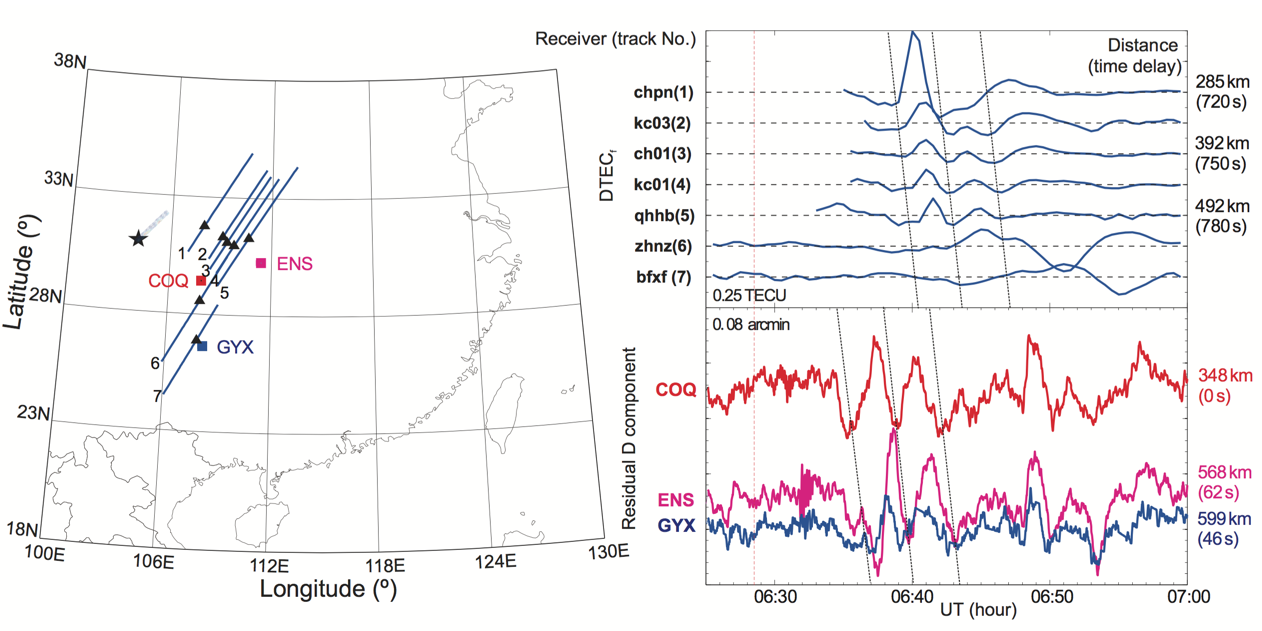Ionospheric and geomagnetic disturbances caused by the 2008 Wenchuan earthquake: A revisit Biqiang Zhao1 and Yongqiang Hao2 ([email protected])
1Key Laboratory of Earth and Planetary Physics, Institute of Geology and Geophysics, Chinese Academy of Sciences, Beijing, China 2Department of Geophysics, Peking University, Beijing, China
Despite primary energy disturbances from the Sun, oscillations of the Earth surface due to a large earthquake will couple with the atmosphere and therefore the ionosphere, then the so-called coseismic ionospheric disturbances (CIDs) or seismotraveling ionospheric disturbances (STIDs) can be detected in the ionosphere.
Previous works have shown that coseismic ionospheric disturbances (CIDs) after the tsunamigenic 2011 Tohoku earthquake (Tohoku EQ, Mw9.1) covered a vast area and were observed thousands of kilometers away from the epicenter. For the purpose of making a comprehensive comparison between powerful oceanic and inland EQs, we conduct a retrospective investigation of CIDs and geomagnetic responses to the 2008 Wenchuan EQ (Mw7.9) using a combination of techniques, total electron content, HF Doppler, and ground magnetometer. It is the very first study to present CIDs recorded by different techniques at co-located sites and profiled with regard to changes of both ionospheric plasma and current (geomagnetic field) simultaneously. The integrated observation also shows that (1) in the Wenchuan case, most of the ionospheric and geomagnetic disturbances were observed within 1000?km distance which is far less than the Tohoku case; (2) two groups of CIDs were found with maximum amplitudes in the direction of azimuth 150 and 135, respectively; and (3) the geomagnetic changes were only registered by three magnetometers located to the east and southeast of the epicenter. All the facts indicate that the main directional lobe of Wenchuan EQ energy propagation is to southeast and perpendicular to the direction of the fault rupture, but this kind of directivity is not that distinct in the Tohoku case. We suggest that the different fault slip (inland or submarine) affecting the way of couplings of lithosphere with atmosphere may contribute to the discrepancies between the two events.

A combination of ionospheric and geomagnetic disturbances after the earthquake. (left) The SIP traces of Satellite 31 and locations of the three geomagnetic stations (solid squares). (right) The DTECf and residual geomagnetic D component. The coexistence of geomagnetic and TEC changes is clearly shown that the double-peak structure of TEC seen between the three dashed lines is also detected in the D component
This research was supported by the National Basic Research Program of China (2012CB957801 and 2011CB811405), NSFC (41274155, 41174138, 41131066, 41304126) and ISTCP (2014DFR21280).
Zhao, B., and Y. Hao* (2015), Ionospheric and geomagnetic disturbances caused by the 2008 Wenchuan earthquake: A revisit, J. Geophys. Res. Space Physics, 120, doi:10.1002/2015JA021035.
